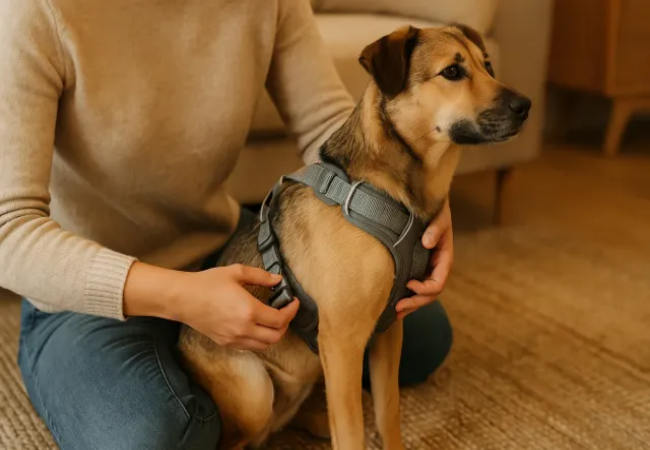Dog Harness Fit Guide 2025: Vet Tips for Comfort & Safety 🩺🐶

In this article
Dog Harness Fit Guide 2025: Vet Tips for Comfort & Safety 🩺🐶
By Dr. Duncan Houston BVSc
A dog harness that’s too tight can cause chafing, panic, and pain. Too loose? Your dog might slip out. So, what’s the right fit?
As a veterinarian and product designer at Woopf, I’ve helped thousands of dogs get properly fitted harnesses—whether they’re energetic puppies, strong pullers, or recovering from injury. This guide will help you get it right the first time.
📏 The Two-Finger Rule
This is the gold standard. You should be able to fit two fingers snugly between the harness strap and your dog’s body. This applies to all main straps: neck, chest, and girth.
- If you can’t fit two fingers → Too tight
- If you can fit your whole hand → Too loose
🧠 Why Proper Fit Matters
Improper fit can lead to:
- Chafing or hair loss (under armpits or chest)
- Restricted breathing or shoulder movement
- Increased pulling behavior or anxiety
- Risk of slipping out of the harness
Vet Note: According to PubMed and Elsevier veterinary studies, improper leash and harness pressure can contribute to respiratory strain and gait changes, especially in flat-faced or deep-chested breeds.
🪢 How to Adjust a Dog Harness (Step-by-Step)
- Loosen all straps completely before first wear.
- Place the harness on your dog with the front pad centered over the chest.
- Adjust chest straps first—these sit behind the front legs and support the core.
- Then adjust shoulder straps to hold the harness in place comfortably.
- Finish with the neck strap if applicable (for Y-front designs).
Test with movement: Can your dog sit, lie down, and stretch without rubbing or gapping?
🎯 Breed-Specific Fit Tips
🐶 Small Breeds (Pomeranian, Maltese, Yorkie)
Use lightweight gear like the Sherpa Harness. Watch for tight armpits or chest pressure. Their bodies are delicate and prone to tracheal collapse, so avoid anything high on the neck.
🐕 Medium to Large Breeds (Golden Retriever, Husky, GSP)
Choose adjustable harnesses with dual D-rings like the Explorer Harness. Check that the belly strap sits 2–4 fingers behind the front legs for proper balance.
🐾 Flat-Faced Breeds (Pug, Frenchie, Bulldog)
Use a low-cut, chest-conforming design like the Sealskin Waterproof Harness that avoids neck compression.
🧪 Fit Test: Check These 5 Areas
- Neck: Shouldn’t touch the throat or ride too high
- Chest: Strap lies across the chest, not up near the neck
- Belly: No pinching behind front legs
-
Movement: Dog can move shoulders and legs freely
- Escape check: Harness shouldn’t shift with side-to-side movement
🛍️ Fit-Perfect Harnesses from Woopf
- Explorer Harness: All-size fit with reflective chest panel
- Sherpa Harness: Soft-touch fabric for puppies & toy breeds
- Bungee Lead: Reduces jolt from pulling—great for imperfect fits or training
🎁 Comfort-Boosting Extras
For post-walk relaxation, combine your harness with:
- Dual Pocket Treat Bag – Rewards and walk-time gear in one
Conclusion
Your dog’s harness should feel like a second skin—secure but never restrictive. Use the two-finger rule, check fit zones often, and don’t hesitate to size up or switch styles if your dog’s body changes over time.
Every Woopf harness is vet-designed, fully adjustable, and made for real dogs in the real world. Ready to find the perfect fit?



